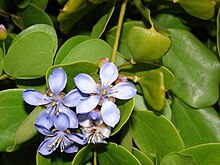Guayacán
| Guaiacum | |
|---|---|
 |
|
| Guaiacum officinale | |
| Scientific classification | |
| Kingdom: | Plantae |
| (unranked): | Angiosperms |
| (unranked): | Eudicots |
| (unranked): | Rosids |
| Order: | Zygophyllales |
| Family: | Zygophyllaceae |
| Subfamily: | Larreoideae |
| Genus: |
Guaiacum L. |
| Type species | |
|
Guaiacum sanctum L. |
|
| Species | |
|
Guaiacum angustifolium |
|
Guaiacum angustifolium
Guaiacum coulteri
Guaiacum officinale
Guaiacum sanctum
Guaiacum unijugum
Guaiacum (/ˈɡwaɪ.ə.kəm/), sometimes spelled Guajacum, is a genus of flowering plants in the caltrop family Zygophyllaceae. It contains five species of slow-growing shrubs and trees, reaching a height of approximately 20 m (66 ft) but are usually less than half of that. All are native to subtropical and tropical regions of the Americas and are commonly known as lignum-vitae, guayacán (Spanish), or gaïac (French). The genus name originated in Maipurean, the language spoken by the native Taínos of the Bahamas; it was adopted into English in 1533, the first word in that language of American origin.
Members of the genus have a variety of uses, including as lumber, for medicinal purposes, and as ornamentals. The trade of all species of Guaiacum is controlled under CITES Appendix II.
...
Wikipedia
